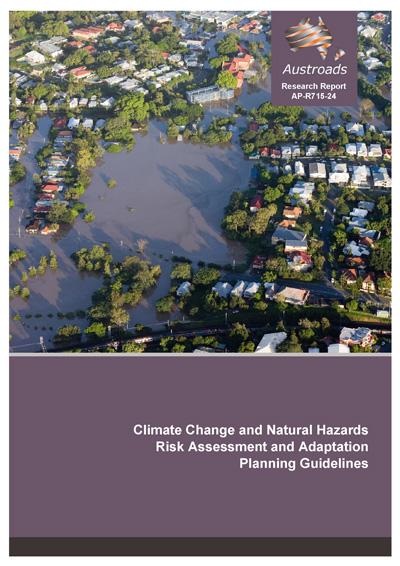Environment

Climate Change and Natural Hazards Risk Assessment and Adaptation Planning Guidelines
- Publication no: AP-R715-24
- ISBN: 978-1-922994-46-2
- Published: 11 November 2024
- PDF (free) Download
The Climate Change and Natural Hazard Risk Assessment Guidelines set out a framework for Australian and New Zealand transport agencies to consider when undertaking climate change and natural hazard risk assessments and developing adaptation plans. Examples are provided throughout.
The guidelines are intended to be flexible, covering the application of both high-level and detailed risk assessments of physical and transition risks.
The guidelines are informed by leading practices in Australia, New Zealand, and internationally. Supporting resources, such as publicly available tools and datasets, are also included.
- Summary
- 1. Introduction
- 1.1 Purpose
- 1.2 Scope
- 1.3 Drivers for completing an assessment
- 2. Background
- 2.1 Climate change, natural hazards and their impacts
- 2.2 The transition to a low-carbon economy, impacts and opportunities
- 2.3 Links to other organisational processes
- 2.4 Assessing risk across the asset lifecycle
- 2.5 Stakeholder engagement
- 3. An Overview of the Assessment Process
- 4. Determining the Type of Assessment Required
- 4.1 Planning
- 4.2 Design and construction
- 4.3 Operation and maintenance
- 4.4 Renewal and rehabilitation
- 4.5 Reuse or disposal
- 5. Step 1: Establishing the Context
- 5.1 Defining objectives and establishing an assessment team
- 5.1.1 Defining objectives and the level of detail
- 5.1.2 Establishing an assessment team
- 5.2 Selecting assets and hazards
- 5.2.1 Selecting assets
- 5.2.2 Selecting hazards and risk drivers
- 5.3 Selecting timeframes
- 5.4 Selecting climate scenarios
- 5.5 Collecting data on assets and hazards
- 5.6 Defining the risk framework
- 5.1 Defining objectives and establishing an assessment team
- 6. Step 2: Identification, Analysis and Evaluation of Risks
- 6.1 Risk identification
- 6.2 Risk analysis
- 6.3 Risk evaluation
- 7. Step 3: Adaptation
- 7.1 Identifying adaptation options
- 7.2 Assessing and prioritising adaptation options
- 7.2.1 Updating the risk register
- 7.3 Documenting residual risks
- 8. Reporting, Monitoring and Reviewing
- 8.1 Preparing a risk assessment report and adaptation plan
- 8.2 Preparing monitoring approach
- 8.3 Reviewing
- References
- Appendix A Pre-screening
- Appendix B Example Hazards and Impacts
- B.1 Physical hazards and impacts
- B.2 Transition risks
- B.2.1 Reviewing existing policies and processes
- B.2.2 Market trend analysis
- B.2.3 Transition drivers and risks
- Appendix C Assessing Criticality and Vulnerability
- C.1 Determining criticality
- C.2 Assessing vulnerability
- C.2.1 Assessing exposure
- C.2.2 Assessing sensitivity
- C.2.3 Assessing adaptive capacity
- Appendix D Climate and Natural Hazard Data
- Appendix E Example Risk Framework
- Appendix F Example Adaptation Options for Transport Infrastructure
- F.1 Adapting to physical risks
- F.2 Adapting to transition risks
- Appendix G Determining the Optimal Scale and Timing of Adaptation
- G.1 Sensitivity testing
- G.2 Adaptive management
Related publications
Latest Environment News
